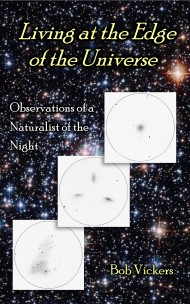Believe it or not, there were a few clear nights in February. Although very cold (think polar vortex!), the transparency was excellent and I managed to view a few more Hickson Compact Galaxy Groups. Many of the individual galaxies in these groups are very dim and I was unable to see all the galaxies in any given group.
The first group was Hickson 31, AKA the NGC 1741 group. This is a very interesting group with two heavily interacting galaxies, NGC 1741 and P16573. These two are listed as the “a” and “c” elements of Hickson 31. The brightest is actually P16573 as it contains the central starburst which shows as a bright stellar nucleus. NGC 1741 is only visible as a vague, hazy extension of P16573 to the ENE. Even though the “b” element, P16570, is listed as brighter than N1741, I could not make it out. Neither could I see the tiny and ridiculously dim d element, P16571, at magnitude 17.3. I could, however, see another galaxy (IC399) a few arc minutes to the SE. This roundish galaxy which becomes brighter toward the center is not listed in the Astronomical League GG&C booklet but is listed in other sources as element “g”, a possible member of the group. The distance to Hickson 31 is given as about 166 million light years.
I only managed to see one galaxy in the next group, Hickson 22, before the clouds moved in. NGC 1199 appeared slightly elongated SW/NE with a stellar nucleus. It is by far the largest and brightest of the group at mag 12.2, but I did not even have a chance to look for the other elements. I will have to re-visit this group sometime in the future.
I could see only the two brightest galaxies in Hickson 32, M-3-13-53 and P16578. Both were small, round, fuzzy spots of light with M-3-13-53 having a dim star-like nucleus.
Lastly, I observed the brightest two galaxies of Hickson 33, P16867 and P16866. They were both small, round, fuzzy spots with no stellar nuclei. I was surprised to be able to see them at all due to their magnitudes of 15.4. I figured that I was probably only able to see them because the group was very high in the sky with a +18.0 degree declination so I was looking through much less atmosphere. None of the galaxies in this group were even plotted in Uranometria.


